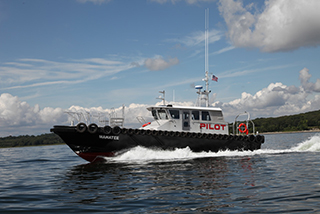The Tampa Bay Pilots Association has taken delivery of its second Chesapeake-class launch and the first in a new generation of Gladding-Hearn Shipbuilding’s midsize pilot boats.
Dubbed the Chesapeake-class MKII, the vessel has a deep-V hull designed by C. Raymond Hunt & Associates. The 52’7”x16’8”x4’5” all-aluminum boat is powered by twin Volvo Penta D11, six cylinder, EPA Tier 3 diesel engines, each producing 503 hp at 2,250 rpm. Each engine is connected to a Volvo IPS propulsion pod, which is fitted with dual forward facing, counterrotating propellers and integrated exhaust system, and Volvo’s integrated EPS electronic steering and control system.
“The IPS 2 system was created to improve the performance and the arrangement of planning hulls like our pilot boats,” said Peter Duclos, president of the Somerset, Mass.-based shipyard. “This new generation of Chesapeake launche is equipped with the IPS 2 pods, which provide what pilots have been asking for — higher speeds, lower fuel consumption, and more comfort.”
As part of that effort to cater to pilots' specific needs, a Humphree interceptor automatic trim-optimization system was installed.
“The combination of the Volvo Penta IPS system and the Humphree interceptors gives the pilots higher speeds and improved comfort, while burning 25% less fuel than similar Chesapeake-class launches,” Duclos said.
A Northern Lights generator, with 9 kW of output, provides electricity. The electronics suite includes a Furuno DRS4D radar. The vessel’s top speed is 28 knots.
Some additional key design changes separate the MKII vessels from their predecessors. The wheelhouse is positioned aft of amidships to improve comfort and provide for a larger foredeck. With the propulsion pods close-coupled to the engines, the engine room is located well aft of the wheelhouse with easy access to machinery through a deck hatch.
This new generation of pilot boats is also designed to accept a gyro-stabilization system to reduce vessel roll. The wheelhouse, with forward leaning windows, is outfitted with five Stidd seats and a settee and cooled by two 16,000-Btu air conditioning units. The forecastle, with a 12,000-Btu unit, has one berth and an enclosed head.
Outside of the wheelhouse are wide side-decks and boarding platforms, port and starboard, on the foredeck. At the transom is a winch-operated, rotating davit over a recessed platform for pilot rescue operations.




